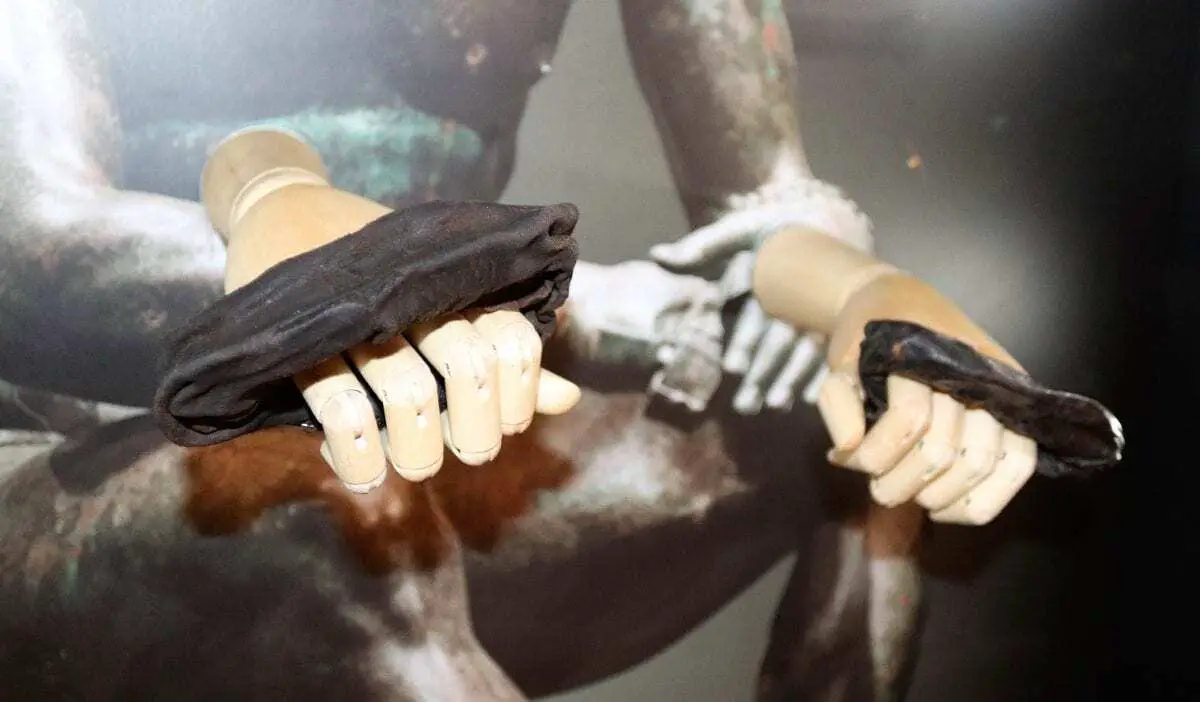During the summer of 2017 Vindolanda archaeologists enjoyed one of their most successful annual research excavation seasons to date with one remarkable discovery after another coming to light.
A small hoard of wafer thin Vindolanda Writing Tablets, many full of ancient cursive script, was quickly followed by a cache of material culture uncovered during the excavation of a pre-Hadrianic cavalry barrack.
The finds included complete swords, copper alloy horse gear, more precious writing tablets, leather shoes, bath clogs, combs, dice and two very unusual and distinctive pieces of leather. These two unusual leather objects have very similar attributes in terms of style and function, although they are not a matching pair, and they could not be likened to any of the many thousands of leather items previously discovered at Vindolanda.
Unlike the modern boxing glove these ancient examples have the appearance of a protective guard, designed to fit snugly over the knuckles protecting them from impact. The larger of the two gloves is cut from a single piece of leather and was folded into a pouch configuration, the extending leather at each side were slotted into one another forming a complete oval shape creating an inner hole into which a hand could still easily be inserted. The glove was packed with natural material acting as a shock absorber. This larger glove has extreme wear on the contact edge and it had also undergone repair with a tear covered by a circular patch. The slightly smaller glove was uncovered in near perfect condition with the same construction but filled with a tight coil of hard twisted leather.
The two gloves can still fit comfortably on a modern hand. They have been skilfully made, with the smaller glove retaining the impression of the wearer’s knuckles. It is likely that the gloves functioned as sparring or practice caestu each has a stiffened contact edge being a softer representation of the of the more lethal metal inserts used in ‘professional’ ancient boxing bouts. It is thought that the larger glove may have been unfit for purpose due to prolonged use and may have survived alongside the ‘newer’ model resulting from a personal attachment given to it by the owner.
Boxing was a well-documented ancient sport that preceded the Roman era. In the context of the Roman Army it was a recorded pursuit, a martial activity designed to increase the skills and fitness of the boxers. Boxing competitions also took place with crowds and supporters and it was also the sort of activity that the Roman garrisons would have gambled on.
Dr Andrew Birley, CEO and The Vindolanda Trust’s Director of Excavations commented “I have seen representations of Roman boxing gloves depicted on bronze statues, paintings and sculptures but to have the privilege of finding two real leather examples is exceptionally special.” Dr. Birley went on to say “what really makes Vindolanda so unique is the range of organic objects that we find. Every one of them brings you closer to the people who lived here nearly 2,000 years ago but the hairs stand up on the back of your neck when you realise that you have discovered something as astonishing as these boxing gloves.”
Header Image: Research of the objects at Vindolanda along with the considered observations by Roman leather and other experts has indicated that these leather objects are in fact boxing gloves – Image Credit : Vindolanda Trust





